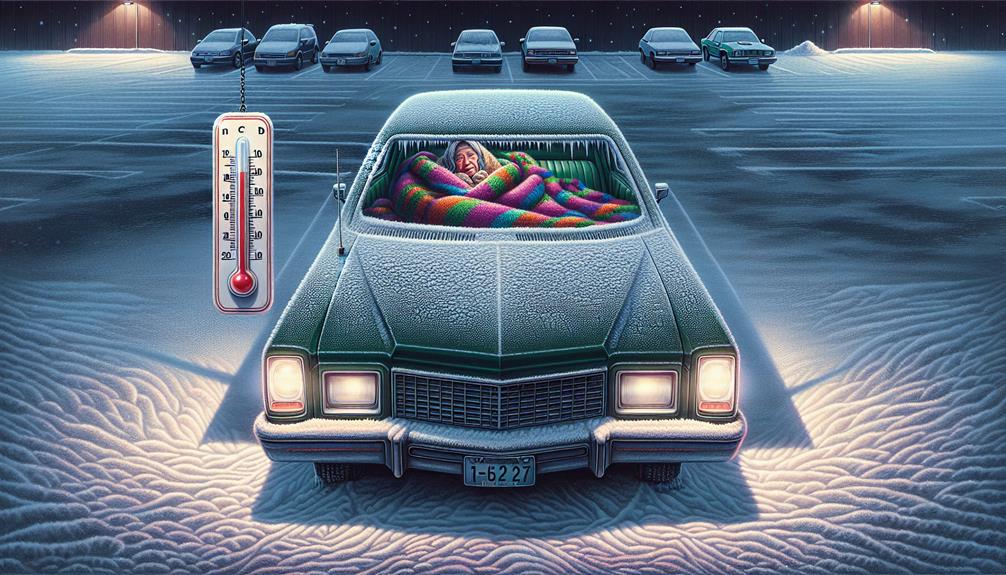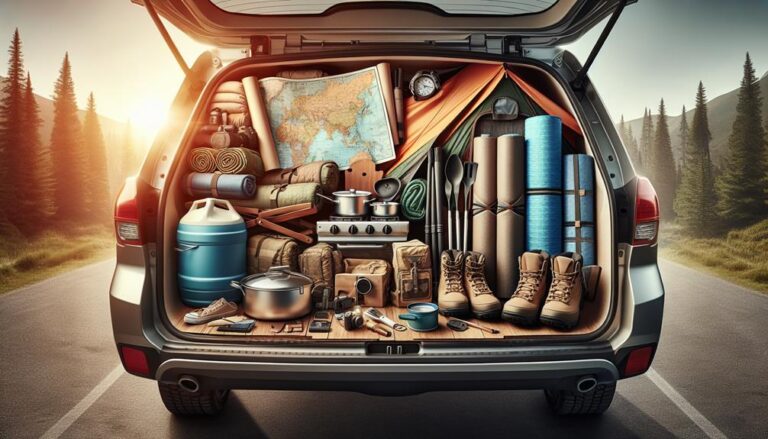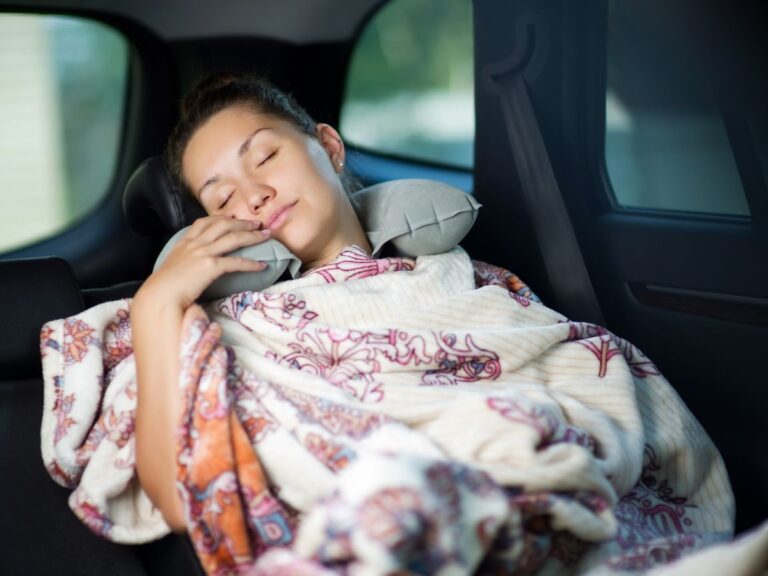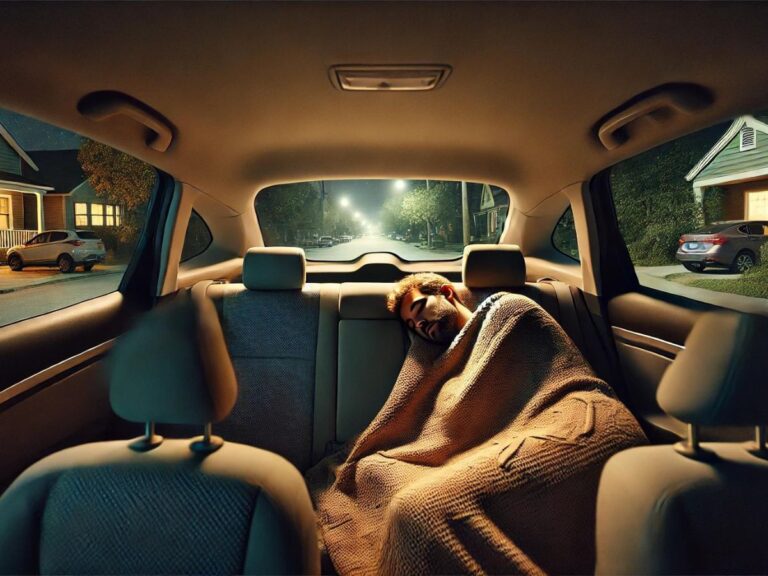Unveiling the Risks of Sleeping in My Car in Freezing Weather
Sleeping in your car in freezing weather increases risks like hypothermia, carbon monoxide poisoning, frostbite, and limited insulation. These dangers can lead to severe health issues or even death if not addressed promptly. Prioritize warmth and insulation, guarantee proper ventilation, and recognize early signs of frostbite. Prevention includes dressing appropriately, sealing gaps for better insulation, and following safety precautions. Continuing to be informed about these risks is vital for your well-being in challenging weather conditions.
Hypothermia
In freezing weather, sleeping in a car without proper insulation can lead to the dangerous condition of hypothermia. Cold exposure is a significant risk factor for developing hypothermia, especially when the body loses heat faster than it can produce it. Factors such as low outside temperatures, inadequate clothing, and lack of heating in the vehicle can exacerbate the risk. The human body relies on maintaining a core temperature of around 98.6 degrees Fahrenheit (37 degrees Celsius) for best functioning. When exposed to extreme cold, the body’s internal temperature can drop, leading to symptoms like shivering, confusion, slurred speech, and drowsiness. Severe cases of hypothermia can result in organ failure, coma, and even death if not treated promptly. It is important to prioritize warmth and insulation when sleeping in a car during cold weather to mitigate the risk of hypothermia and safeguard your safety.
Carbon Monoxide Poisoning
Carbon monoxide poisoning poses a significant threat when sleeping in a car in freezing weather. This colorless, odorless gas is produced by the incomplete combustion of carbon-containing fuels, such as gasoline, wood, or propane. The confined space of a car can quickly accumulate dangerous levels of carbon monoxide, putting you at risk while you sleep.
Warning signs of carbon monoxide poisoning include headache, dizziness, weakness, nausea, vomiting, chest pain, and confusion. To guarantee this, make sure your exhaust pipe is not blocked by snow or any other obstacle, crack your car windows slightly to allow for ventilation, and never run the engine with the windows closed.
In case of suspected carbon monoxide poisoning, immediately open all doors and windows to ventilate the car, move to fresh air, and seek medical attention. Long term effects of carbon monoxide exposure can include neurological damage and heart problems. Taking precautions and being aware of the warning signs can save your life in such situations.
Frostbite
You must recognize frostbite symptoms promptly to prevent serious tissue damage. Preventing frostbite involves keeping extremities warm and dry, as well as avoiding prolonged exposure to cold temperatures. If you suspect frostbite, seek medical attention immediately for proper treatment of frostbitten skin.
Frostbite Symptoms
Experiencing numbness, tingling, or a pale appearance in your extremities are common early symptoms of frostbite. When exposed to freezing temperatures, your skin and underlying tissues can freeze, leading to frostbite. As the condition progresses, the affected area may become hard, cold to the touch, and turn a bluish or gray color. Severe frostbite can cause blistering, numbness, and even tissue death.
Critical treatment is essential in preventing permanent damage from frostbite. If you suspect frostbite, seek emergency medical assistance immediately. While awaiting help, gently warm the affected area without rubbing or massaging it. Remove any wet clothing and replace it with dry, warm layers. Avoid walking on frostbitten feet to prevent further injury.
To lower the risk of frostbite, prioritize frostbite prevention by dressing appropriately for cold weather. Wear insulated, waterproof clothing, including gloves, hats, and boots. Remain vigilant for early symptoms of frostbite, especially when sleeping in a car in freezing weather. Being aware of these symptoms and taking swift action can help prevent the progression of frostbite and protect your well-being.
Preventing Frostbite
To prevent frostbite, dressing appropriately for cold weather with insulated, waterproof clothing is essential. Proper insulation is key to maintaining body heat and preventing frostbite when sleeping in a car in freezing weather. Insulated layers such as thermal underwear, fleece jackets, and thick socks help retain body heat and create a barrier against the cold. Waterproof outer layers are vital in keeping moisture out, as wet clothing can increase the risk of frostbite.
In addition to clothing, it’s important to protect extremities like hands, feet, nose, and ears, as they are more susceptible to frostbite. Wearing insulated gloves, warm hats, and waterproof boots can help safeguard these areas from extreme cold. Properly covering exposed skin and avoiding tight clothing that restricts blood flow are also essential in frostbite prevention. Being mindful of wind chill factor and taking breaks to warm up indoors can further reduce the risk of frostbite. Remember, prevention is key to staying safe in freezing temperatures.
Treating Frostbitten Skin
When treating frostbitten skin, immediate and important actions are essential to prevent further damage and promote healing. Frostbitten skin care begins with gently rewarming the affected area. Avoid rubbing or massaging the skin, as this can cause more harm. Instead, immerse the frostbitten skin in warm water at a temperature of around 104-107.6°F (40-42°C) for 15-30 minutes until normal color and sensation return. It’s vital to seek medical treatment promptly to assess the severity of the frostbite and receive proper care.
Medical treatment for frostbite may include pain management, wound care, and potential antibiotics to prevent infection. In severe cases, surgery or hospitalization might be necessary. Follow-up care is essential to monitor healing and prevent complications. Preventing frostbite recurrence involves staying warm, dressing in layers, keeping skin dry, and avoiding prolonged exposure to cold temperatures. Prioritize winter safety by being aware of weather conditions and taking precautions to protect yourself from frostbite. Remember, swift and appropriate action is key when it comes to treating frostbitten skin.
Limited Insulation
In freezing weather, limited insulation in a car can greatly impact your ability to retain body heat and stay warm. During winter survival situations or when exposed to extreme temperatures, the insulation within your vehicle plays a pivotal role in maintaining a comfortable and safe internal environment. Insufficient insulation can lead to rapid heat loss, putting you at risk of hypothermia and other cold-related illnesses.
Cars with inadequate insulation may struggle to retain the warmth generated by your body or heating sources, making it challenging to create a sustainable level of heat within the vehicle. This can be especially dangerous in extremely cold conditions, where the lack of proper insulation exacerbates the impact of the low external temperatures.
To enhance your winter survival in such circumstances, consider utilizing additional blankets, sleeping bags, or thermal insulation to improve the overall warmth retention within your car. Additionally, sealing gaps or cracks in windows and doors can help minimize heat loss and create a more insulated sleeping environment. Prioritizing adequate insulation is essential for staying safe and comfortable while sleeping in your car during freezing weather.
Risk of Accidents
You must be aware of the heightened driving hazards in winter due to icy roads and reduced visibility. To mitigate the risk of accidents while sleeping in your car in freezing weather, safety precautions such as making sure your vehicle is visible to other drivers and having emergency supplies on hand are essential. Data shows that taking these measures can greatly reduce the likelihood of accidents and ensure your safety during cold weather conditions.
Driving Hazards in Winter
Winter weather brings increased risks of accidents on the roads due to hazardous driving conditions such as ice and snow. When driving in winter, you must be mindful of the following:
- Black Ice: This transparent ice on road surfaces is hard to spot and extremely slippery, increasing the likelihood of losing control.
- Reduced Visibility: Snowfall and fog can impair your ability to see other vehicles and road signs.
- Ice Patches: These patches can form unexpectedly, causing sudden loss of traction and potential skidding.
- Tire Pressure: Cold weather can lead to decreased tire pressure, affecting your vehicle’s handling and braking capabilities.
- Slush: Melting snow can create slushy conditions, reducing grip and making it harder to steer effectively.
To lessen these risks, make sure your tires are properly inflated, maintain a safe following distance, and drive at reduced speeds when road conditions are poor. Remember, safety should always be your top priority when traveling on winter roads.
Safety Precautions Needed
Managing the increased risk of accidents during winter weather conditions requires strict adherence to safety precautions to mitigate potential hazards on the road. When preparing for a journey in freezing weather, make sure your vehicle is equipped with emergency supplies such as a flashlight, blankets, non-perishable food, water, and a first aid kit. These items can be vital in case of an accident or breakdown. Additionally, wearing appropriate winter clothing, including insulated layers, gloves, hats, and sturdy boots, can help you stay warm and comfortable in case you need to step out of the car in freezing temperatures.
It is essential to drive cautiously, allowing for increased braking distances and reduced speeds. Be aware of black ice, a thin and transparent ice layer that forms on roads, making them extremely slippery. Maintaining a safe following distance from other vehicles is also critical to prevent accidents. Remember to check weather and road conditions before setting off, and if conditions worsen, consider delaying your trip or finding a safe place to pull over until conditions improve. By taking these precautions, you can reduce the risk of accidents and ensure a safer winter driving experience.
Dehydration
Staying hydrated is essential when sleeping in a car in freezing weather to prevent dehydration. In cold weather, your body loses moisture through breathing and skin evaporation faster than you might realize. Adequate water intake is vital for winter survival. Here are some hydration management tips to keep in mind:
- Drink water regularly: Set a schedule to drink water throughout the day, even if you don’t feel thirsty.
- Avoid excessive caffeine: While a warm cup of coffee can be comforting, too much caffeine can contribute to dehydration.
- Monitor urine color: Dark yellow urine indicates dehydration, aim for pale yellow to clear urine.
- Eat hydrating foods: Fruits like watermelon and vegetables like cucumber have high water content to help with hydration.
- Use insulated water bottles: Keep water from freezing by using insulated bottles or storing them in a thermally insulated bag.
Lack of Ventilation
To guarantee maximum safety and comfort when sleeping in your car in freezing weather, it is essential to address the issue of inadequate ventilation. Lack of ventilation can lead to condensation build-up inside the vehicle, which increases the risk of moisture-related problems such as mold and mildew. Additionally, poor air quality due to a lack of fresh airflow can result in respiratory issues and discomfort during your rest.
Proper ventilation is important to regulate humidity levels inside the car and prevent condensation from forming on windows and surfaces. To improve ventilation, crack open a window slightly to allow fresh air to circulate while still maintaining a safe sleeping environment. Consider using a portable fan if necessary to enhance airflow and reduce the chances of condensation build-up.
Monitoring the air quality inside your car is crucial for your health and well-being while sleeping in freezing temperatures. By addressing the issue of inadequate ventilation, you can create a safer and more comfortable sleeping environment during cold weather conditions.
Legal Concerns
Addressing legal concerns when sleeping in your car in freezing weather is essential for ensuring compliance with local regulations and maintaining your safety. To navigate this complex landscape, consider the following key points:
- Parking Regulations: Familiarize yourself with local laws regarding where you can park overnight. Some areas may have restrictions on sleeping in vehicles in public spaces.
- Liability Concerns: Understand the legal implications if an accident were to occur while you are sleeping in your car. Consult with legal experts to protect yourself.
- Homelessness Rights: Be aware of your rights as someone experiencing homelessness. Certain protections may apply to you in specific situations.
- Vehicle Safety: Regularly maintain your vehicle to make sure it is safe for sleeping in cold weather. Check heating systems and fuel levels before resting.
- Privacy Laws: Respect privacy regulations even when sleeping in your car. Avoid public indecency or disturbances to others in the vicinity.
Staying informed and compliant with legal requirements is important for your well-being when sleeping in your car during freezing weather.
Mental Health Impact
Understanding the mental health impact of sleeping in your car in freezing weather is essential for mitigating potential risks and promoting overall well-being. Sleep deprivation is a significant concern when enduring cold temperatures in a vehicle. Research shows that inadequate sleep can lead to heightened levels of anxiety, impacting your ability to cope with stressors effectively. The combination of sleep deprivation and the stress of living in freezing conditions can exacerbate feelings of anxiety, making it important to prioritize rest and relaxation.
Depression is another potential consequence of sleeping in your car during cold weather. The sense of isolation and lack of stable housing can contribute to feelings of hopelessness and sadness. It is crucial to recognize the signs of depression early on and seek support from mental health professionals or support groups. Additionally, the social isolation that often accompanies homelessness can further compound feelings of depression, emphasizing the importance of staying connected with friends, family, or community resources. Prioritizing mental health and seeking help when needed is essential for dealing with the challenges of sleeping in your car in freezing weather.
Risks and Precautions for Sleeping in Your Car in Freezing Weather
To summarize, sleeping in your car in freezing weather poses numerous risks, including hypothermia, carbon monoxide poisoning, frostbite, limited insulation, risk of accidents, dehydration, lack of ventilation, legal concerns, and mental health impacts. It is vital to be aware of these dangers and take necessary precautions to guarantee your safety and well-being during cold nights. Remember to prioritize your health and seek alternative shelter options when facing extreme weather conditions.







